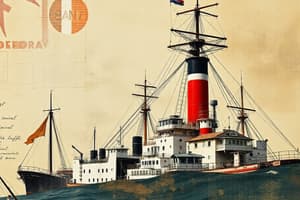Podcast
Questions and Answers
What is essential for ensuring safe navigation with ARPA?
What is essential for ensuring safe navigation with ARPA?
- Turning off ARPA in heavy traffic
- Constantly updating ARPA software
- Comprehensive tracking of multiple targets (correct)
- Relying solely on ARPA for navigation
What is a best practice for effective use of ARPA?
What is a best practice for effective use of ARPA?
- Regularly cross-checking ARPA data with visual observations and other navigation tools (correct)
- Ignoring ARPA data and relying on visual observations
- Turning off ARPA in low-traffic areas
- Updating ARPA software only during maintenance periods
Why is it important to understand ARPA's strengths and limitations?
Why is it important to understand ARPA's strengths and limitations?
- To rely solely on ARPA for navigation
- To never update ARPA software
- To ignore potential issues with ARPA
- To adjust reliance on the system and supplement it with other navigation tools (correct)
Why is continuous learning important for effective use of ARPA?
Why is continuous learning important for effective use of ARPA?
What is the importance of situational awareness in ARPA operation?
What is the importance of situational awareness in ARPA operation?
What should mariners do when ARPA indicates a potential collision risk?
What should mariners do when ARPA indicates a potential collision risk?
What is the importance of risk mitigation in ARPA operation?
What is the importance of risk mitigation in ARPA operation?
Why is it important to recognize ARPA's weaknesses?
Why is it important to recognize ARPA's weaknesses?
What is the benefit of understanding ARPA's limitations?
What is the benefit of understanding ARPA's limitations?
What is the importance of proactive responses in ARPA operation?
What is the importance of proactive responses in ARPA operation?
Flashcards
ARPA
ARPA
Automatic Radar Plotting Aid; a tool for tracking vessels.
Target Tracking Capabilities
Target Tracking Capabilities
ARPA automatically acquires and tracks nearby vessels' movements.
Continuous Tracking
Continuous Tracking
ARPA updates target position, course, and speed in real-time.
Target Loss Circumstances
Target Loss Circumstances
Signup and view all the flashcards
Target Swop
Target Swop
Signup and view all the flashcards
Limitations of ARPA
Limitations of ARPA
Signup and view all the flashcards
Situational Awareness
Situational Awareness
Signup and view all the flashcards
Best Practices for ARPA Use
Best Practices for ARPA Use
Signup and view all the flashcards
Environmental Impact on ARPA
Environmental Impact on ARPA
Signup and view all the flashcards
Risk Mitigation
Risk Mitigation
Signup and view all the flashcards
Study Notes
ARPA: Automatic Radar Plotting Aid
- ARPA is a vital navigation tool that automatically tracks and displays the movement of nearby vessels, providing critical information for safe maritime travel.
Target Tracking Capabilities
- ARPA can automatically acquire and initiate tracking on nearby vessels, providing a comprehensive view of surrounding traffic.
- ARPA analyzes the trajectories of tracked targets, alerting the user to potential collision risks and suggesting appropriate course corrections.
Continuous Tracking
- Once a target is acquired, ARPA maintains continuous tracking, updating its position, course, and speed in real-time.
Circumstances Leading to Target Loss and Alarm Activation
- Obstructed Line of Sight: ARPA may temporarily lose track of a target if it is obscured by land, other vessels, or poor weather conditions.
- Radar Interference: Electromagnetic interference or radar shadowing can disrupt ARPA's ability to maintain a reliable lock on a target.
- Target Maneuvers: Sudden or erratic changes in a target's speed or course can cause ARPA to lose its tracking solution, triggering an alarm.
- System Limitations: ARPA has limitations in accurately tracking small, slow-moving, or highly maneuverable targets, which can lead to loss of track and alarm activation.
Effect of "Target Swop" on Displayed Data
- Target swop occurs when ARPA inadvertently switches its tracking from one target to another, often due to similar characteristics.
- When a target swop occurs, the displayed data, including speed, course, and collision avoidance information, will suddenly change to reflect the new, unintended target.
Limitations of ARPA in Tracking Targets
- Small Targets: ARPA may struggle to accurately track small vessels, such as fishing boats or pleasure craft, due to their limited radar cross-section.
- Slow-Moving Targets: Targets moving at very slow speeds can be challenging for ARPA to acquire and maintain reliable tracking on.
- Highly Maneuverable Targets: Targets that make sudden, erratic changes in speed or course can exceed ARPA's ability to predict their movements and maintain a stable track.
- Poor Environmental Conditions: Heavy rain, fog, or sea clutter can degrade ARPA's performance, leading to loss of target tracking and unreliable data.
Importance of Understanding ARPA's Capabilities and Limitations
- Situational Awareness: Knowing ARPA's strengths and limitations allows mariners to anticipate potential issues and ensures safer navigation.
- Effective Operation: Understanding ARPA's capabilities and weaknesses helps mariners maintain a comprehensive and supplementary use of other navigation tools.
- Risk Mitigation: Recognizing ARPA's limitations helps mariners take appropriate actions to avoid collision hazards.
- Continuous Learning: Staying up-to-date on evolving technologies and ARPA's capabilities ensures mariners can make the most of this valuable navigation aid.
Best Practices for Effective Use of ARPA
- Continuous Monitoring: Regularly cross-checking ARPA data with visual observations and other navigation tools is crucial for maintaining situational awareness.
- Careful Interpretation: Understanding the limitations of ARPA helps mariners accurately interpret the displayed information.
- Proactive Responses: When ARPA indicates a potential collision risk, taking timely and appropriate action is essential for ensuring safe navigation.
Studying That Suits You
Use AI to generate personalized quizzes and flashcards to suit your learning preferences.
Description
Learn about the Automatic Radar Plotting Aid (ARPA) system, a vital tool in maritime navigation that tracks and displays nearby vessels, providing critical information for safe travel. Understand its target tracking capabilities and collision avoidance features.




